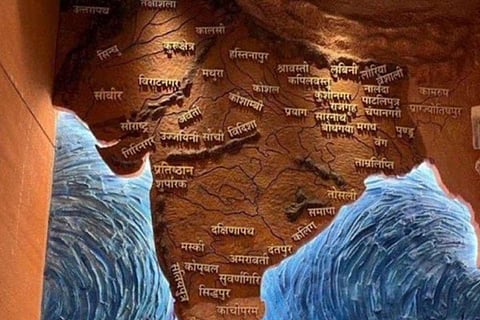

The Akhand Bharat mural on the walls of the new Parliament House seems to have triggered not only a furious debate on social media, but also drawn international protests, neighbouring Nepal being first in line. The mural shows a map of ‘Akhand Bharat’ with names of ancient Indian kingdoms engraved on it.
‘Akhand Bharat’ is an umbrella term that portrays the countries of Afghanistan, Pakistan, Maldives, Sri Lanka, Myanmar, Bangladesh, and India as one nation. The idea of ‘Akhand Bharat’, as per many Hindu nationalist organisations, is as old as Indian or Vedic civilisation and has purportedly been described in the ancient Indian scriptures.
There are different definitions of the ‘Akhand Bharat' based on different perspectives and ideologies. Some view it as a cultural concept that represents the historical and geographical extent of Indian civilization. Others view it as a political concept that advocates the ‘reunification’ of the territories that were once part of British India or ancient India.
Hindu nationalist organisations such as the Rashtriya Swayamsevak Sangh (RSS) and the Hindu Mahasabha have expressed their support for ‘Akhand Bharat’. RSS has propagated this idea through various publications such as Bodhmala, and media as well. They have described the word ‘Rashtra’ as a combined region with cultural similarities, Hinduism being the dominant motif.
Ironically, the first international protest has come from Nepal, which is also a Hindu-majority state - Baburam Bhattarai, former Prime Minister and leader of the Nepal Socialist Party has termed the mural as controversial and warned that the mural might lead to an unnecessary and harmful diplomatic row in the neighbourhood. In his tweet he has also challenged Indian political leaders to clarify their intent.
The controversial mural of ‘Akhand Bharat’ in the recently inaugurated new Parliament building of India may stoke unnecessary and harmful diplomatic row in the neighborhood including Nepal. It has the potential of further aggravating the trust deficit already vitiating the… pic.twitter.com/dlorSZ05jn
— Baburam Bhattarai (@brb1954) May 30, 2023
Twitterati meanwhile have attributed various meanings to the mural. Some have depicted it as “a step towards a Hindu Rashtra,” while others have praised Prime Minister Modi for his tireless efforts towards achieving such an ideal.
This Pic is the loudest statement made from the biggest house of the country!
— AadhiraSpeaks (@AadhiRaSpeaks) May 28, 2023
Read the names.. #ViratNagar#Sindhu#Souveer#Purushpur#Uttarapath
This is the beginning of #AkhandBharat #NewParliamentBuilding pic.twitter.com/2NZY8utYuS
Somebody intuites this is just a picture. But in this, collosal meaning is behind this. You will see that in near future very soon. Even every indian and i want to see eagerly. #MyParliamentMyPride #AkhandBharat pic.twitter.com/sgTgY36mOh
— Angry Young Man (@AngryYoungManly) May 29, 2023
The Karnataka faction of the BJP tweeted pictures of the mural and captioned it as the “symbol of the vitality of our proud great civilization”.
ನೂತನ ಸಂಸತ್ ಭವನದ ಒಳಾಂಗಣ ವಿನ್ಯಾಸದ ಕೆಲ ಚಿತ್ರಗಳು.
— BJP Karnataka (@BJP4Karnataka) May 28, 2023
ಇದು ನಮ್ಮ ಹೆಮ್ಮೆಯ ಭವ್ಯ ನಾಗರಿಕತೆಯ ಜೀವಂತಿಕೆಯ ಸಂಕೇತ.
ಪ್ರಧಾನಿ ಶ್ರೀ @narendramodi ಅವರಿಗೆ ಧನ್ಯವಾದಗಳು #MyParliamentMyPride
1/2 pic.twitter.com/qR4e1GMdlW
There was a tweet with a picture of the Prime Minister holding the Sengol - a sceptre that represents the idea of the righteousness of a ruler - and attributing religious significance to the Prime Minister’s rule by depicting him as a great devotee of Lord Shiva.
"It is our order that a Shiva devotee, will rule this country like heavens are ruled" #myparilamentmypride #akhandbharat #Sengol @narendramodi pic.twitter.com/nCxRWd3LDV
— Shubham Tripathi (@imshubtripathi) May 28, 2023
On the other hand, a Twitter user has criticised this idea of ‘Akhand Bharat,’ citing the mural as provocative and as being driven by the BJP’s vote-bank politics.
Are we deliberately provoking our neighboring countries with this map of #India depicting #AkhandBharat?
— Gaurav Prakash (@GauravPrakashSP) May 29, 2023
It's evident that Indian foreign policy has hit rock bottom due to the disastrous policies of @narendramodi's decade. China's unrestrained and aggressive advances towards… pic.twitter.com/W4ZXLlurj2